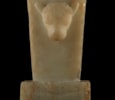Inscribed Bull Stele
Inscribed Bull Stele
3rd Century B.C. to 1st Century A.D.
Yemen
Alabaster
H: 36.2 cm
Sold
Trapezoidal in form, carved in very high relief, with the form of a bull’s head with ribbed brows and a rounded snout. The horns now missing. Inserted onto a rectangular alabaster base upon which is a Qatabanian inscription, which reads: ʾlʿm S¹flyn – the name of a man.
These carved bull stelae are almost certainly ritual objects. The name of a man possibly indicates a funerary intent, with the deceased name recorded. The bull, however, was sacred in ancient South Arabia and is a commonly occurring religious motif and could therefore indicate that this sculpture once adorned a temple.
It is reputed to have come from Hayd ibn 'Aqil, the necropolis of ancient Timna’, located a little to the north of the city. Timna’ was the capital of the ancient kingdom of Qataban, one of the richest kingdoms of ancient South Arabia, whose wealth derived largely from its strategic position along the Incense Route, as a trading point for merchants dealing in spices, most importantly frankincense, myrrh and cinnamon. According to the Roman author Pliny the Elder, who died in 79 A.D., Timna’ was a bustling city with some sixty-five temples. Excavations suggest a major fire forced its inhabitants to abandon the city sometime in the first century A.D
Sir Antonin Besse, Tony Besse’s father, gifted a collection of South Arabian sculptures to the British Museum in the 50s, amongst which were three carved bull stelae – one of which was similarly inscribed with the name of a man, Ab’am Hazr, and was also reputed to have come from Beihan.
Reputedly from Beihan, probably from Hayd ibn 'Aqil, the necropolis of ancient Timna'.
Antonin Besse (1927-2016) and Christiane Besse (1928-2021), Aden and Paris, acquired in Yemen in 1960, collection number CB60 (recorded for export to France by the Department of Antiquities, Aden State, in April 1967).
Thence by descent to their children Antonin and Joy-Isabelle Besse, 14th February 2021.
ALR: S00218617, with IADAA certificate, this item has been searched against the Interpol database.
Antonin ‘Tony’ Besse II (1927-2016) was the sixth child and third son of the prominent French-born, Aden-based businessman Antonin Besse and his second wife Hildra Crowther. His father, a passionate anglophile and prominent anti-Nazi, founded St. Anthony’s College, Oxford, was forever immortalised as Mr Baldwin in Evelyn Waugh’s novel Scoop, and was described by the travel writer and explorer Freya Stark as “a merchant in the style of the Arabian Nights”. He was a shrewd businessman who by 1923 controlled 72 per cent of the Red Sea oil trade, and in 1936 installed the first diesel engines in Arab dhows, building up a fleet that could operate in all weathers carrying mutton from Berbera to Aden.
Born in the south of France, Tony Besse II spent his youth running errands for the French resistance in the Alpilles. His formal education ended after he stood up in assembly and shouted at the headmaster, a Vichy supporter. He was interrogated but the Italian officer had been in Somalia and knew of his father, and cried, “You have your life in front of you. Run!”
Spells as a resistance fighter and, post-war, working the black market followed. At one point, after an argument with his father in Aden, he jumped on one of the company’s ships to New York and worked for a spell as an unlicensed taxi driver. After his father’s death in 1951 he took over the running of the family business, aged 24. During the 60s the couple was actively involved in the excavations at Palmyra and in Libya. Besse ran the family company until it was lost to Communist control, as their interests were nationalised in 1969. He eventually made a home in Paris, but his heart remained in the war-torn Middle East.
In later life he was persuaded by Kurt Hahn, his father’s great friend and the founder of Gordonstoun, to help fund the founding of what is now UWC Atlantic, buying St Donat’s Castle, a 12th century castle in South Wales once owned by William Randolph Hearst.
Christiane Besse (1928-2021) was born in Senegal, the daughter of a soldier, and grew up in Morocco before moving to France to study. She became a journalist in the 1950s, and was sent to Yemen, where she became the first French female journalist to report on affairs there. She met Tony Besse in 1957. In later life she was an editor and translator and was the first person to translate the works of William Boyd, James Baldwin and others into French.
Their astonishing collection was started by Tony Besse’s father, Antonin Besse, who had bequeathed a large portion of his collection to the British Museum, where it still resides. It was, however, under the erudite and careful nurturing of Christiane Besse that the collection flourished. Her children, Antonin and Joy-Isabelle, have written of her intelligence and also of her uncanny foresight in preserving the export certificates obtained from the last days of the British Protectorate, something which almost all other Southern Arabian pieces sadly lack. She and Tony continued to collect on their relocation to Beirut in the 60s, however, when Lebanon fell into the chaos of a civil war they returned to France, and did not add again to their collection, having lost so many esteemed friends, including archaeologists and antiquarians with whom they had carefully worked to curate their collection.
This collection of first-rate Southern Arabian items represents, then, the passionate love of an cultivated and international couple who had made their home in the Middle East, before war and the changing political scene forced them back to Europe.










 Enquire
Enquire




